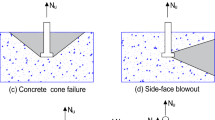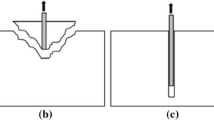Abstract
Cast-in fasteners, like headed-studs, are important elements widely used in safety-critical applications of the building industry. They allow the connection of structural components through transfer of stresses from load-bearing elements to concrete. Their tensile strength in an unconfined configuration with wide supports depends on the concrete’s mechanical properties. Despite numerous studies performed on the short-term behaviour of cast-in anchors, little information is available on their sustained-load behaviour and the effect of the loading rate on their load capacity. The present research aims at studying these two effects by performing an experimental investigation consisting of sustained load tensile tests on cast-in headed studs. Firstly, short-term tests at different loading rates were performed. Secondly, long-term sustained load tests were performed at different load levels with respect to the ultimate load capacity. Two sets of anchors installed in two different concretes were tested. The first set consisted of 10 anchors tested to failure at different loading rates while sustained load tests were executed on additional 11 anchors. The second consisted of 14 anchors, 3 of which were tested to failure to determine their ultimate capacity and the remaining anchors were subjected to sustained loads at different load levels. The corresponding displacements and time-to-failure were continuously measured throughout the long-term tests. The results were used to construct time-to-failure curves where the load level is plotted against the time-to-failure in a semi logarithmic scale. The lifetime prediction of the anchors was assessed by applying a new model based on a sigmoid function. The predicted sustained load values for a 50-year service life are noticeably lower than the short-term capacity but remain larger than the characteristic load calculated according to standards for the design of cast-in anchors.










Similar content being viewed by others
References
Rolf Eligehausen (1987) Anchorage to concrete by metallic expansion anchors. American Concrete Institute, Farmington Hills, MI: Anchorage to Concrete, SP-103-10, pages 181–201
Rolf Eligehausen and Gottfried Sawade (1989) A fracture mechanics based description of the pull-out behavior of headed studs embedded in concrete. RILEM report - fracture mechanics of concrete structures: from theory to applications. Chapman and Hall, London
Stone William C, Carino Nicholas J (1983) Deformation and failure in large-scale pullout tests. ACI J Proc 80(6):501–513
Krenchel H, Shah SP (1985) Fracture analysis of the pullout test. Mater Struct 18:439–446
Fuchs W, Eligehausen R, Breen J (1995) Concrete cone apacity design (ccd) approach for fastening to concrete. ACI Struct J 92:73–94
J. Ožbolt, R. Elighausen, and H.W. Reinhardt. (1999) Size effect on the concrete cone pull-out load. Int J Fract 95(1):391–404
Giovanni Di Luzio and Luigi Cedolin. (2020) Simulation of anchor failure by tension or shear load. In Computational Modelling of Concrete Structures, pages 709–716. CRC Press
ACI Committee 318 (1995) Building code requirements for structural concrete : (ACI 318-95) ; and commentary (ACI 318R-95). Farmington Hills, MI : American Concrete Institute
EN-1992-4:2009 (2009) Eurocode 2–Design of concrete structures-Part 4: Design of fastenings for use in concrete. European comittee for standarization Brussels
Fib Special Activity Group 4 (2011) Design of Anchorages in Concrete: Part I-V. Lausanne , (fib Bulletin 58). International Federation for Structural Concrete (fib)
Comité Euro-International Du Béton (CEB) (1994) CEB Bulletin 216: Fastenings to concrete and masonry structures, State of the Art Report. Thomas Telford, London
Comité Euro-International Du Béton (CEB) (1994) CEB Bulletin 206 & 207: Fastenings to reinforced concrete and masonry structures, State of the Art Report (Vol. 1 and 2). Thomas Telford, London
Rolf Eligehausen, Werner Fuchs, Ulrich Ick, Rainer Mallée, Martin Reuter, Klaus Schimmelpfennig, and B Schmal (1992) Tragverhalten von kopfbolzenverankerungen bei zentrischer zugbeanspruchung. Bauingenieur, 67:183–196
European Organization for Technical Approvals EOTA. EAD 330232-00-0601: Mechanical fasteners for use in concrete. EOTA, 2016
H.W. Reinhardt and H.W.A. Cornelissen (1985) Zeitstandzugversuche in beton. Baustoffe ’85, Bauverlag, Wiesbaden, pages 162–167
Al-Kubaisy MA, Young AG (1975) Failure of concrete under sustained tension. Mag Con Res 27(92):171–178
Domone PL (1974) Uniaxial tensile creep and failure of concrete. Mag Concre Res 26(88):144–152
Reinhardt HW, Weerheijm J (1991) Tensile fracture of concrete at high loading rates taking account of inertia and crack velocity effects. Int J Fract 51(1):31–42
Zdenĕk P, Bažant and Ravindra Gettu. (1992) Rate effects and load relaxation in static fracture of concrete. ACI Mater J 89(5):456–468
Fan Ping Zhou (1992) Time-dependent crack growth and fracture in concrete. Technical report, Lund Univ.(Sweden). Dept of Building Technology
Bažant Zdeněk P, Jirásek Milan (1993) R-curve modeling of rate and size effects in quasibrittle fracture. Int J Fract 62(4):355–373
Zdenĕk P, Bažant, Wei-Hwa Gu, and Katherine T Faber. (1995) Softening reversal and other effects of a change in loading rate on fracture of concrete. ACI Mater J 92(1):3
G Di Luzio and L Cedolin. (2007) Numerical model for time-dependent fracturing of concrete structures and its application. 1: 175–180. Taylor & Francis
Di Luzio Giovanni (2009) Numerical model for time-dependent fracturing of concrete. J Eng Mech 135(7):632–640
Cusatis Gianluca (2011) Strain-rate effects on concrete behavior. Int J Impact Eng 38(4):162–170
Cook Ronald A, Douglas Elliot P, Davis Todd M, Liu Changhua (2009) Adhesive Anchors in Concrete Under Sustained Loading Conditions. The National Academies Press, Washington, DC
Cook Ronald A, Douglas Elliot P, Davis Todd M, Liu Changhua (2013) Long-Term Performance of Epoxy Adhesive Anchor Systems. The National Academies Press, Washington, DC
Eligehausen Rolf, Blochwitz Ronald, Fuchs Werner (2012) Behavior and design of adhesive anchors under sustained load. ACI Symp Publicat 283:1–14
Boumakis Ioannis, Krešimir Ninčević, Jan Vorel, and Roman Wan-Wendner. (2019) Creep rate based time-to-failure prediction of adhesive anchor systems under sustained load. Compos Part B Eng 178:107389
Krešimir Ninčević, Ioannis Boumakis, Stefan Meissl, and Roman Wan-Wendner. (2020) Consistent time-to-failure tests and analyses of adhesive anchor systems. Appl Sci 10(4):1527
Kränkel T, Lowke D, Gehlen C (2015) Prediction of the creep behaviour of bonded anchors until failure—a rheological approach. Construct Build Mater 75:458–464
Nilforoush Rasoul, Nilsson Martin, Söderlind Gunnar, Elfgren Lennart (2016) Long-term performance of adhesive bonded anchors. ACI Struct J 113(2):251–261
European Organization for Technical Approvals EOTA. EAD 330499-01-0601: (2018) Bonded fasteners for use in concrete. EOTA
AC58, ICCES. Acceptance Criteria for Adhesive Anchors in Concrete and Masonry Elements. International Code Council Evaluation Service (ICC-ES), Inc., Whittier, CA, 2005
Podroužek Jan, Wan-Wendner Roman (2018) Uncertainty analysis of the power law extrapolation techniques for adhesive anchors. Struct Concrete 19(6):1760–1770
Boumakis Ioannis, Di Luzio Giovanni, Marcon Marco, Vorel Jan, Wan-Wendner Roman (2018) Discrete element framework for modeling tertiary creep of concrete in tension and compression. Eng Fract Mech 200:263–282
Giovanni Di Luzio and Gianluca Cusatis. (2009) Hygro-thermo-chemical modeling of high performance concrete. i: Theory. Cement and Concrete composites, 31(5):301–308
Giovanni Di Luzio and Gianluca Cusatis. (2009) Hygro-thermo-chemical modeling of high-performance concrete. ii: Numerical implementation, calibration, and validation. Cement and Concrete composites, 31(5):309–324
Zdeněk P Bažant and Milan Jirásek. Creep and hygrothermal effects in concrete structures, volume 225. Solid Mechanics and Its Applications, Springer, 2018
Rossi Pierre, Tailhan Jean-Louis, Le Maou Fabrice, Gaillet Laurent, Martin Eric (2012) Basic creep behavior of concretes investigation of the physical mechanisms by using acoustic emission. Cement Concrete Res 42(1):61–73
Zdenek P. Bažant. Creep and damage in concrete. J. Skalny, S. Mindess (Eds.), Materials science of concrete IV, American Ceramic Society, Westerville, OH, pages=355–389, year=1995, publisher=American Ceramic Society, Westerville, OH
Forest C Monkman. An empirical relationship between rupture life and minimum creep rate in creep-rupture tests. In Proc of the ASTM, volume 56, pages 593–620, 1956
Frank Garofalo. Fundamentals of creep and creep-rupture in metals (creep and creep rupture in metals and alloys, fundamental information for instruction and reference). NEW YORK, MACMILLAN CO., LONDON, COLLIER- MACMILLAN, LTD., 1965. 258 P, 1965
Povolo F (1965) Comments on the monkman-grant and the modified monkman-grant relationships. J Mater Sci 20(6):2005–2010
Bažant ZP, Gettu Ravindra (1992) Rate effects and load relaxation: static fracture of concrete. ACI Mater J 89(5):456–468
Bažant Zdeněk P, Caner Ferhun C, Adley Mark D, Akers Stephen A (2000) Fracturing rate effect and creep in microplane model for dynamics. J Eng Mech 126(9):962–970
Watstein D (1953) Effect of straining rate on the compressive strength and elastic properties of concrete. ACI J Proc 49(4):729–744
Hubert Rusch. (1960) Researches toward a general flexural theory for structural concrete. ACI J Proc 57(7),
van Zijl GPAG, de Borst R, Rots JG (2001) The role of crack rate dependence in the long-term behaviour of cementitious materials. Int J Solids Struct 38(30):5063–5079
Rossi Pierre, Van Mier Jan G. M, Toutlemonde François, Le Maou Fabrice, Boulay Claude (1994) Effect of loading rate on the strength of concrete subjected to uniaxial tension. Mater Struct 27(5):260–264
Darko Tasevski, Miguel Fernández Ruiz, and Aurelio Muttoni. Analogy between sustained loading and strain rate effects on the nonlinear creep response of concrete. CONCREEP 10 Proceedings: Mechanics and Physics of Creep, Shrinkage, and Durability of Concrete and Concrete Structures, pages 1187–1193, 2015
Miguel Fernández Ruiz, Aurelio Muttoni, and Pietro Gambarova. Relationship between nonlinear creep and cracking of concrete under uniaxial compression. Journal of Advanced Concrete Technology, 5(3):383–393, 10 2007
ACI Comitee 374.2R-13. Guide for testing reinforced concrete structural elements under slowly applied simulated seismic loads. American Concrete Institute, 2013
ASTM C512/C512M-10. Standard Test Method For Creep Of Concrete In Compression. ASTM international, 2019
EN 12390-17:2019 (2019). Testing hardened concrete - Part 17: Determination of creep of concrete in compression. CEN/TC 104/SC,
Krešimir Ninčević. Doctoral thesis: Influence of coarse aggregate, concrete age and loading duration on anchorage to concrete. Universität für Bodemkultur Wien, 2020
Hughes BP, Watson AJ (1978) Compressive strength and ultimate strain of concrete under impact loading. Mag Concrete Res 30(105):189–199
Acknowledgements
This investigations was the result of a team effort for which the authors would like to thank the UGent laboratory team. The financial support by the Austrian Federal Ministry of Economy, Family and Youth and the National Foundation for Research, Technology and Development is gratefully acknowledged for concrete B. The authors would also like to thank the people who participated in the casting and characterization of concrete B including Stefan Meissl, Gilda Daissé, Carina Marx and Sabine Führer.
Funding
Partial financial support was received by the Austrian Federal Ministry of Economy, Family and Youth and the National Foundation for Research, Technology and Development.
Author information
Authors and Affiliations
Contributions
Study conception and design were performed by Roman Wan-Wendner, Giovanni Di Luzio, Ioannis Boumakis, Krĕsimir Ninčević and Andrea Carolina Oña Vera. Material preparation, data collection and analysis of the concrete properties were performed by Andrea Carolina Oña Vera for concrete A and by Lisa-Marie Sinn for concrete B. Material preparation, data collection and analysis of the tensile tests in headed-studs were performed by Andrea Carolina Oña Vera for both concretes. The first draft of the manuscript was written by Andrea Carolina Oña Vera and all authors commented on previous versions of the manuscript. All authors read and approved the final manuscript.
Corresponding author
Ethics declarations
Conflict of interest
The authors declare that they have no known competing financial interests or personal relationships that could have appeared to influence the work reported in this paper
Additional information
Publisher's Note
Springer Nature remains neutral with regard to jurisdictional claims in published maps and institutional affiliations.
Rights and permissions
Springer Nature or its licensor (e.g. a society or other partner) holds exclusive rights to this article under a publishing agreement with the author(s) or other rightsholder(s); author self-archiving of the accepted manuscript version of this article is solely governed by the terms of such publishing agreement and applicable law.
About this article
Cite this article
Oña Vera, A.C., Boumakis, I., Ninčević, K. et al. Experimental investigation of the loading rate effect and the sustained load effect in the concrete cone capacity of cast-in anchors. Mater Struct 56, 152 (2023). https://doi.org/10.1617/s11527-023-02228-3
Received:
Accepted:
Published:
DOI: https://doi.org/10.1617/s11527-023-02228-3




